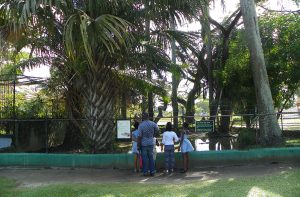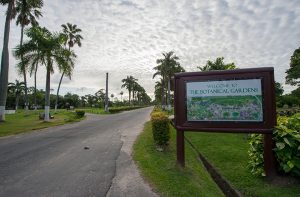GUYANA’S Urban Parks are among the few places within the city that provide large recreational spaces and opportunities to interact with nature for Guyanese and visitors. People find solace in green spaces, and enjoy doing many different activities in the areas such as various types of recreational activities, health, wellness, exercise and fitness activities, various sports. These spaces even provide educational benefits. Guyana’s most prominent green spaces — the Botanical Gardens and the Zoological Park, the National Park and the Joe Vieira Park — are urban parks that are part of the National Protected Areas System area managed by the Protected Areas Commission (PAC) which oversees the National Parks Commission (NPC). For many people, these parks serve as a temporary escape from the hustle and bustle of the day-to-day urban activities – a convenient escape because distant, lengthy and expensive travel is not required to enjoy their beauty and convenience. Urban Parks also enhance the physical appearance of urban communities, offering an aesthetically pleasing landscape that interrupts the monotony of the typical urban environment.
 Research has shown that green spaces especially with lots of trees and vegetation can filter air, and despite the fact that Guyana does not have major air pollution issues compared to elsewhere in the world, the PAC takes comfort in believing that our parks contribute to the maintenance of good air quality in the environment. This, in turn, promotes and supports better respiratory health for the nation’s people. It is also worth mentioning that the Urban Parks managed by the PAC, in addition to their flora, also provides roosting, nesting and feeding habitats for many species of birds as well as reptiles such as small caiman, and mammals such as monkeys and manatees.
Research has shown that green spaces especially with lots of trees and vegetation can filter air, and despite the fact that Guyana does not have major air pollution issues compared to elsewhere in the world, the PAC takes comfort in believing that our parks contribute to the maintenance of good air quality in the environment. This, in turn, promotes and supports better respiratory health for the nation’s people. It is also worth mentioning that the Urban Parks managed by the PAC, in addition to their flora, also provides roosting, nesting and feeding habitats for many species of birds as well as reptiles such as small caiman, and mammals such as monkeys and manatees.
Today we will focus on two of our urban parks.
THE BOTANICAL GARDENS
The Botanical Gardens is a 35-hectare green space established in 1879. It offers a unique look back at Guyana’s history and culture through its monuments and iconic colonial structures which blend with the picturesque trees and flowers to create a well-balanced space for recreation and solitude. The Botanical Gardens also boasts one of the largest collections of species of palms in the city, in addition to its unique landscape at the western section of the Gardens, where the flora replicates various ecosystems of Guyana, such as grassy savannas and swampy forests. This area is home to over 200 species of birds, along with small mammals, reptiles and amphibians. It is one of the richest biodiversity hotspots in the city of Georgetown, and is popular among bird enthusiasts.
The Botanical Gardens also carries an intricate pond system that connects through the entire expanse of the land area. This pond system is home to West Indian manatees and small caimans, and extends all the way through the Zoo, which is comprised of 2 hectares of the Botanical Gardens.
ZOOLOGICAL PARK AND REHABILITATION CENTRE
 The Guyana Zoo was opened in 1952, and its two (2) hectares makes it the smallest member of the National Protected Areas System (NPAS). It serves as a learning and recreation centre for visiting patrons, with up to 10,000 visitors coming to view the animals every month. The Zoo operates as a wildlife education and rehabilitation centre, and provides a safe haven for many rescued, endangered, injured, abandoned, and unwanted wild animals.
The Guyana Zoo was opened in 1952, and its two (2) hectares makes it the smallest member of the National Protected Areas System (NPAS). It serves as a learning and recreation centre for visiting patrons, with up to 10,000 visitors coming to view the animals every month. The Zoo operates as a wildlife education and rehabilitation centre, and provides a safe haven for many rescued, endangered, injured, abandoned, and unwanted wild animals.
The first inhabitant of the Zoo was a Harpy Eagle gifted in 1946. It was this gift that originally prompted the construction of the Zoo on the grounds of the Botanical Gardens. Since then, the Zoo has housed some of Guyana’s “Giants”, and remains home to a Giant River Otter, a Harpy Eagle, a Black Caiman, a Jabiru Stork, Jaguars and Giant River Turtles. The Harpy Eagle, the Jabiru Stork and the Spider Monkeys are the oldest residents of the Zoo, having lived there for over 25 years. These animals are cared for by trained and experienced zookeepers, and a team of technical staff who ensure they are healthy, adequately housed, and given a balanced diet.
The original vision of the Zoo is one for recreation, education, research and conservation. It continues to work towards this vision, and to increase environmental education and awareness among Guyanese. The Protected Areas Commission has developed a master plan for the modernisation of these facilities, which will need financing. It would see the enclosures being reconstructed to replicate natural habitats to improve the overall quality of life for the animals living here.
The Commission encourages persons to make full use of our urban parks, and help to take care of them. In the interest of the welfare of our wildlife, we also encourage persons to avoid removing wildlife from their natural habitats, and to not keep them as pets.
Despite being currently closed due to COVID-19, we take pride in knowing that these green spaces add to an improved quality of life, and they are a part of Guyana’s national patrimony.



.jpg)








